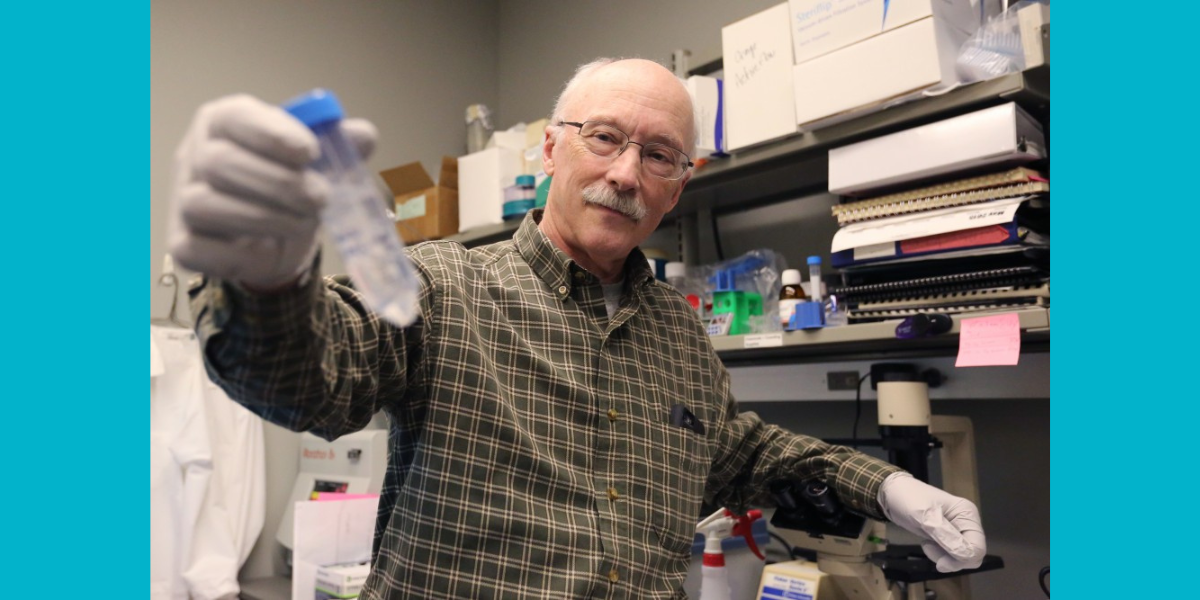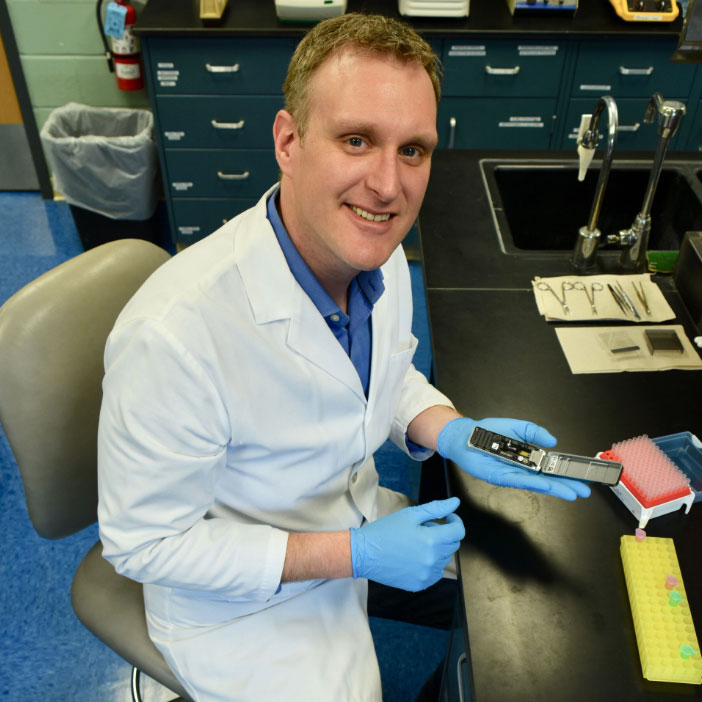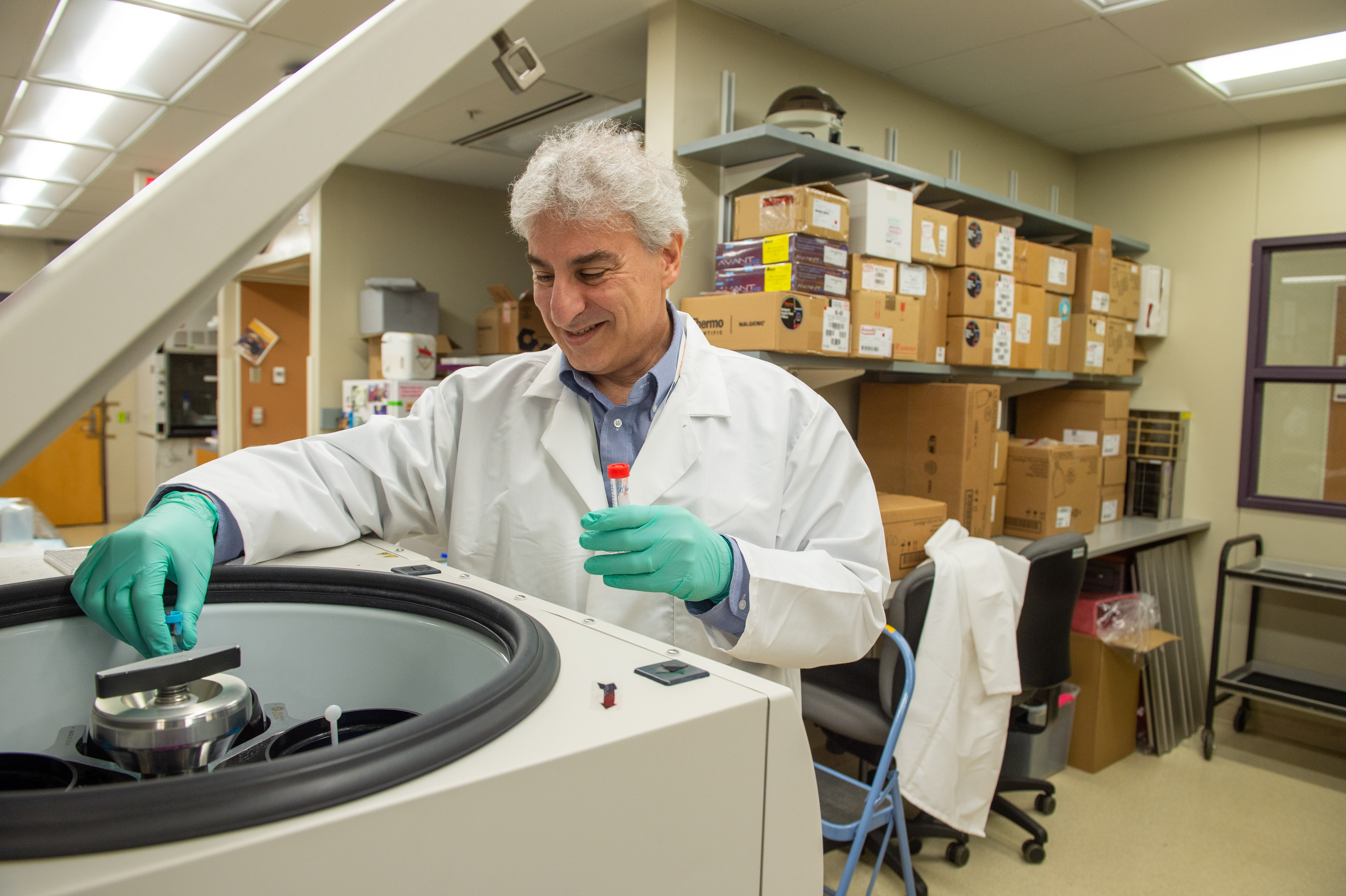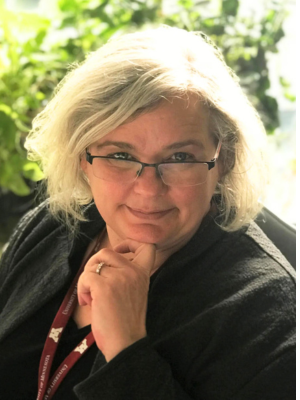Bringing innovation to market
CVM researchers, University solve problems through a combination of science and entrepreneurship

CVM researchers, University solve problems through a combination of science and entrepreneurship
Dr. Timothy O'Brien co-founded a cartilage restoration company called Sarcio after making breakthroughs in stem cell research.
As the College of Veterinary Medicine’s (CVM) associate dean of research, one of Dr. Molly McCue’s goals is to ensure faculty research is harnessed to solve real-world problems.
Often the best way to do that is to combine science and business.
Research at the University of Minnesota (UMN) serves as a launch point for diagnostic tests and therapies that can push human and animal medicine forward. Creating a company to launch products based on university research is a vital step in that process.
“So much of our internal research has the ability to impact the public, but so often, our research grants only take it so far,” McCue says. “If that doesn’t get handed off to a company, often that research doesn’t get translated to something people or animals can use. Working with commercial companies is a really important step to make sure our research has the impact that is intended.”
Since 2006, the UMN has helped launch more than 200 start-ups based on critical research conducted by university experts. The collaborative nature of the campus makes it a uniquely fruitful place for new discoveries.
In 2013, Dr. Timothy O’Brien, a professor and division head of Comparative Pathology in the Department of Veterinary Population Medicine (VPM), was at the heart of such a collaboration.
He was part of a team at the UMN School of Medicine's Stem Cell Institute that was exploring ways to better cultivate stem cells. They were well on their way to engineering an optimal hydrogel—a high-tech gelatin-like material that allows cells to rapidly reproduce in three dimensions rather than two when grown on a culture plate—when another lab at the Institute gave them a particularly versatile type of stem cell called iPSC cells. Derived from skin or blood cells, iPSC cells have the ability to become any type of human cell.
The only caveat is that iPSC cells are extremely difficult to grow. But O’Brien and his team had the hydrogel expertise that put them at the forefront of developing a way to successfully cultivate large numbers of iPSC cells. They knew the ramifications for medicine could be huge but didn’t expect the cells to become the tissues they did.
Within a few weeks of being inoculated into the novel hydrogels, the iPSC cells turned into what appeared to embryonic brain cells. The team thought the synthetically grown cells could one day become a therapy for treating neurological diseases, but the cells required so much oxygen to grow, they would die before they could be used.
Using the resources they had at the Stem Cell Institute, O’Brien and his team figured out a way to pump enough oxygen into the hydrogel to allow the iPSC cells to grow indefinitely––which they did. The cells also made a critical change: They became cartilage.
Understanding what this could mean for osteoarthritis and cartilage injury therapies, such as those in the knee, O’Brien co-founded biopharmaceutical start-up Sarcio, the Latin word for “to repair,” to take the research from lab to real-world product.
“Just being in proximity to other labs that had these cells was critical. If we had just been by ourselves, we wouldn’t have been able to do this,” O’Brien says.
The university’s strong relationships with public and private organizations are also key partnerships that push research from discovery to usable products.
In 2018, the Minnesota Legislature tapped CVM researchers to design a test for chronic wasting disease (CWD) that could be used in live animals. The fatal and highly contagious neurological disease was spreading in deer across the nation, especially in Minnesota.
Peter Larsen, an assistant professor in the Department of Veterinary and Biomedical Sciences and co-director of the Minnesota Center for Prion Research and Outreach (MNPRO), had an idea early on for a test design that could detect pathogens in muscle while an animal was still alive.
“The University was awesome because they helped form the team that could actually develop that test,” Larsen says. “The CVM provided a think tank environment in which we were incredibly productive.”

With help from the university’s Office of Technology Commercialization (OTC), Larsen co-founded the start-up Priogen, which has successfully developed new diagnostic tools and protocols capable of detecting CWD prions—the infectious agents that cause the disease—in a wide variety of sample types.
The company’s flagship service is the world’s first CWD muscle test, which was designed to help prevent CWD prions from entering the food supply through infected meat. While CWD was the original focus of the research, Priogen is expanding its technologies for applications across all prion diseases as well as Parkinson’s, amyotrophic lateral sclerosis (ALS), and Alzheimer’s disease.
With the help of the OTC, the company has filed 10 invention disclosures and five provisional patents just in the past three years.
“The OTC helps the faculty learn how to be part of business meetings, apply for patents, and apply for industry funding opportunities or small business grants,” McCue says.
Over the past decade, the OTC has listened to what potential corporate partners need. In response, the university has streamlined the process of connecting faculty with existing companies that could take their research to the public, through new initiatives such as the MN-IP program.
Being able to take feedback to heart paid off.
“A lot of the industry was saying that working with universities was too slow. But since OTC created MN-IP, we hear from our industry partners that we’re so much easier to work with than other universities,” McCue says.
Research conducted at the university allows faculty to access not only the resources they need for discovery but also an environment that encourages them to pursue them in the first place.
“At the university, we have intellectual freedom. We can research ideas that people may not be able to if they’re working in industry because that research is so tied to the bottom line,” McCue says. “We have a little more leeway. You can go where the science leads you and make discoveries you didn’t expect and those can be very valuable.”
Before he joined the CVM, Dr. Jaime Modiano, Perlman professor of oncology and comparative medicine in the Department of Veterinary Clinical Sciences, was exploring canine hemangiosarcoma, a type of cancer that affects as much as 20 percent of large dog breeds.
It dawned on him that since the tumors form inside the blood vessels, the pressure of blood flow knocks loose tiny bits of the tumor or tumor cells.
“We figured that if we had the right set of molecules to identify the cells that were being knocked loose, we could have a really accurate diagnostic blood test,” says Modiano, who is also the director of the Animal Cancer Care and Research Program, a partnership between the CVM and the Masonic Cancer Center (MCC).

They proved the concept, but it didn’t solve one critical problem: How to treat patients once the potential disease was detected.
Modiano shelved the research until, years later at his lab in the MCC, Dr. Jill Schappa, who at the time was a veterinary student doing research in his lab, stumbled upon researchers in another lab who were working on a targeted cancer therapy, now called eBAT. She asked if she could have some of the drug to study in the Modiano Lab. It was after those serendipitous experiments that the team realized eBAT was something that could work as a therapy to provide the solution for an AI-driven, updated version of Modiano’s shelved diagnostic test.
Modiano worked with the OTC to launch Knine Biotech, now called Companion Bioscience, which was the 200th start-up the UMN had launched since 2006. The start-up is still in the early development phase and has pivoted from focusing on just dogs to both human and animal medicine, with a focus on using tests to determine the biological age of individuals, which is thought to be a driving risk factor for cancer and other chronic diseases.
“Right now we are one of very few companies that are trying to both create a tool to identify the problem and also provide a solution to that problem,” Modiano says.
Pamela Skinner, a professor in the Department of Veterinary and Biomedical Sciences, co-founded MarPam Pharma with a hefty goal at its core: cure HIV.

More than 38 million people around the world are currently living with the virus, which attacks the immune system. Using a combined targeted therapy that first turns a person’s own immune cells into a virus-demolishing army, and then delivers those cells directly to the places in the body where the virus is replicating, MarPam Pharma is moving towards utilizing the very system in the body HIV targets, to eliminate it.
The start-up was born out of UMN research that was able to determine the pathogenesis of HIV, and determine that it hides in a specific location called B cell follicles––the target of MarPam Pharma’s therapy.
The pre-clinical research is funded in part by the National Institutes of Health (NIH), and Skinner and her team are close to getting their initial product in front of the Food and Drug Administration (FDA) for approval for clinical trials.
“We’re constantly innovating to make our product better,” she says. “The final therapy would hopefully allow the person’s own immune system to control their HIV for life.”